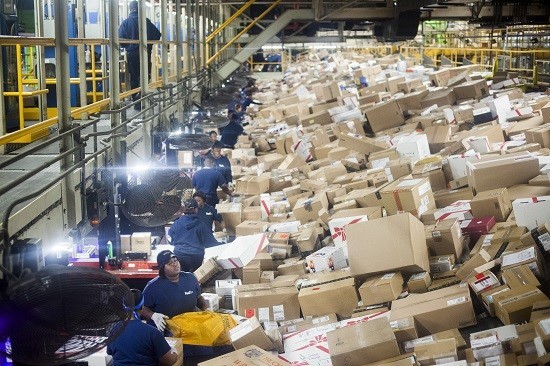The warnings started to stream in early this fall: Shop early or
you may not get your gifts on time.
Global supply chain problems that have led to long delays in manufacturing
and shipping could ripple outward, slowing package deliveries to millions of
Americans in the weeks and days before
Christmas, experts warned. The prospect
even became a talking point in conservative attacks on President
Joe Biden’s
policies.
اضافة اعلان
Despite early fears, however, holiday shoppers have received their
gifts mostly on time. Many consumers helped themselves by shopping early and in
person. Retailers ordered merchandise ahead of time and acted to head off other
bottlenecks. And delivery companies planned well, hired enough people and built
enough warehouses to avoid being crushed by a deluge of packages at the last
minute, as the Postal Service was last year.
The vast majority of packages delivered by
UPS,
FedEx and the
Postal Service this holiday season are gifts destined for residential addresses,
according to ShipMatrix, a software company that services the logistics
industry. And nearly all have arrived on time or with minimal delays, defined
as a few hours late for express packages and no more than a day late for ground
shipments. The UPS and the Postal Service delivered about 99 percent of their
packages on time by that measure between November 14 and December 11, and FedEx
was close behind at 97 percent, according to ShipMatrix.
 Christmas lights and decorations along Main Street in Frankenmuth, Michigan, on December 6, 2021. (Photo: NYTimes)
Christmas lights and decorations along Main Street in Frankenmuth, Michigan, on December 6, 2021. (Photo: NYTimes)
“The carriers have done their part. Consumers have done their part,” said
Satish Jindel, president of ShipMatrix. “When they work together, you get good
results.”
That’s not to say the supply chain turmoil is over. About 100 container
ships are waiting off the West Coast to unload their cargo. Big-ticket items,
such as new cars, are still hard to find because of a shortage of some critical
parts like computer chips. And prices are up for all kinds of goods.
But at least when it comes to items that are in stock, delivery companies
have given consumers little to complain about. By some measures, in fact, they
have done a better job this holiday season than even before the
pandemic.
In
the two full weeks after Thanksgiving, it took about four days from the moment
a package was ordered online for it to be delivered by FedEx, according to data
from
NielsenIQ, which tracks online transactions from millions of online
shoppers in the US. That compares with about 4.6 days for UPS and more than
five days for the Postal Service.
For UPS and FedEx, those figures are an improvement of about 40 percent
from a similar post-Thanksgiving period in 2019, according to NielsenIQ. For
the Postal Service, it was a 26 percent improvement.
“There’s all these different moving parts that have collaborated to help
us get through what might have been a perfect storm to cause problems,” said
Bill Seward, president of worldwide sales and solutions for UPS. “We feel
really good about where we’re at right now.”
The achievement is all the more notable given that Americans are on track
to spend more this holiday season than the one before — up to 11.5 percent over
2020, according to the
National Retail Federation, a trade group.
But this year has been different in a critical way: Many people started
shopping earlier.
Consumer surveys, including those commissioned by UPS and
NPD Group, a
market research firm, found that Americans accelerated their holiday shopping
this year, motivated by shortages, shipping delays or earlier sales from
retailers.
Many Americans also eased pressure on UPS and other delivery companies by
doing more shopping in stores. After consumers switched to online shopping in
droves when the pandemic took hold last year, in-store shopping bounced back
strongly this year, according to retail and logistics experts. In September,
in-store sales accounted for about 64 percent of retail revenue, up 12 points
from its low point during the pandemic, but still somewhat below 2019 levels,
according to NPD Group.
“We miss people,” Katie Thomas, a top consumer analyst at Kearney, a
consulting firm, said about the compulsion to visit stores rather than buy
online. “There’s a pent-up demand. We’re seeing people want to dress up again.”
Retailers and delivery companies also worked behind the scenes to make
sure the supply chain disruptions did not wreak havoc on holiday packages.
Retailers worked harder to forecast sales and moved inventory to areas where
UPS, FedEx and others had more capacity to pick up packages. Companies that
previously relied mostly or exclusively on a single delivery service started doing
business with several companies.
 Employees in an area called the matrix place packages on convertor belts at the FedEx shipping hub in Memphis, Tennessee on December 11, 2014. (Photo: NYTimes)
Employees in an area called the matrix place packages on convertor belts at the FedEx shipping hub in Memphis, Tennessee on December 11, 2014. (Photo: NYTimes)
The delivery companies have spent the past two years building out
capacity, too, in response to surging demand. UPS, which in the past did not
make deliveries on Saturday in much of the country, has been expanding its weekend
service for years. It now offers Saturday deliveries to about 90 percent of the
U.S. population. FedEx has added nearly 15 million square feet of sorting
capacity to its network since June. And, starting in the spring, the Postal
Service, which processes more mail and packages than the other delivery
businesses, started leasing additional space and installing faster
package-sorting machines around the country.
The companies have also responded by raising rates, imposing surcharges
for larger packages that could slow down their networks, limiting the number of
packages they will accept at busy times and penalizing retailers that ship many
more or many fewer packages than they had forecast.
“We used to think that every package was the same,”
Carol Tomé, UPS’s
chief executive, told financial analysts in October, explaining her strategy of
focusing on quality over quantity. “We don’t think that anymore. So for some
shippers, we’re no longer delivering their packages, and that’s OK with us.”
The Postal Service doesn’t have the luxury of easily turning away
business, but even it has done a better job of managing expectations for
holiday package deliveries. Despite the introduction of its first-ever holiday
surcharge last year, its delivery performance suffered. This year, however, it
has fared much better, thanks to 13 million square feet of new processing
space, 112 new high-speed processing machines and the decision to hire
peak-season workers earlier.
“USPS is maybe the most exciting story of all,” said Josh Taylor, senior
director of professional services at Shipware, a consulting firm. “The fact
that they’re not overwhelmed, that their network can continue to deliver on
time, it’s a great development for consumers.”
But the holiday crunch does not end on Christmas. Online returns will keep
delivery companies busy for weeks.
And the pandemic is not yet over. Fear over the spread of the omicron
variant of the coronavirus could drive consumers back to online shopping in the
months to come, which would impose new pressures on delivery companies and
retailers.
Read more Trending



